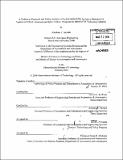| dc.contributor.advisor | Olivier L. de Weck and Annalisa L. Weigel. | en_US |
| dc.contributor.author | Grindle, Abraham T | en_US |
| dc.contributor.other | Massachusetts Institute of Technology. Technology and Policy Program. | en_US |
| dc.date.accessioned | 2010-08-31T14:45:29Z | |
| dc.date.available | 2010-08-31T14:45:29Z | |
| dc.date.copyright | 2010 | en_US |
| dc.date.issued | 2010 | en_US |
| dc.identifier.uri | http://hdl.handle.net/1721.1/57793 | |
| dc.description | Thesis (S.M.)--Massachusetts Institute of Technology, Dept. of Aeronautics and Astronautics; and, (S.M. in Technology and Policy)--Massachusetts Institute of Technology, Engineering Systems Division, Technology and Policy Program, 2010. | en_US |
| dc.description | Cataloged from PDF version of thesis. | en_US |
| dc.description | Includes bibliographical references (p. 73-76). | en_US |
| dc.description.abstract | Engineering, management, and social science methodologies have been employed to analyze a new asset tracking and management system for human spaceflight applications. The Massachusetts Institute of Technology and Aurora Flight Sciences developed Rule-based analytic Asset Management for Space Exploration System (RAMSES) via NASA Small- Business Technology Transfer (STTR) Phase I and Phase II contracts. RAMSES leverages Generation II passive Radio Frequency Identification (RFID) technology to automate the tracking the tens of thousands of small, portable cargo assets that are currently stored onboard the International Space Station (ISS). A Monte Carlo Net Present Value analysis found that RAMSES is likely to have significant positive value for NASA when ISS inventory transactions are concentrated in a subset of the total cargo transfer bag (CTB) population, and/or if ISS Operations are continued into 2018/2020. The volume, mass, and accuracy of the RAMSES system have a significant impact upon the estimated NPV. Testing of the prototype hardware in reduced-gravity conditions reaffirmed the viability of the system. Metals cargo objects were detected with up to 100% accuracy, paper with 96%, and water with roughly 93%. Finally, a comparative analysis of RAMSES and five other NASA Small-Business Innovation Research (SBIR) / Small-Business Technology Transfer (STTR) projects identified three non-technical characteristics and/or informal processes that might be unique to SBIR/STTR technologies that are successfully infused into the mainstream NASA innovation system. These included pre-proposal knowledge exchanges between companies and NASA, strong matching of a project with a relevant NASA COTR, and the availability of an infusion opportunity | en_US |
| dc.description.statementofresponsibility | by Abraham T. Grindle. | en_US |
| dc.format.extent | 105 p. | en_US |
| dc.language.iso | eng | en_US |
| dc.publisher | Massachusetts Institute of Technology | en_US |
| dc.rights | M.I.T. theses are protected by
copyright. They may be viewed from this source for any purpose, but
reproduction or distribution in any format is prohibited without written
permission. See provided URL for inquiries about permission. | en_US |
| dc.rights.uri | http://dspace.mit.edu/handle/1721.1/7582 | en_US |
| dc.subject | Aeronautics and Astronautics. | en_US |
| dc.subject | Engineering Systems Division. | en_US |
| dc.subject | Technology and Policy Program. | en_US |
| dc.title | A technical, financial, and policy analysis of the RAMSES RFID inventory management system for NASA's International Space Station: prospects for SBIR/STTR technology infusion | en_US |
| dc.type | Thesis | en_US |
| dc.description.degree | S.M.in Technology and Policy | en_US |
| dc.description.degree | S.M. | en_US |
| dc.contributor.department | Massachusetts Institute of Technology. Department of Aeronautics and Astronautics | |
| dc.contributor.department | Massachusetts Institute of Technology. Engineering Systems Division | |
| dc.contributor.department | Technology and Policy Program | |
| dc.identifier.oclc | 650355935 | en_US |
